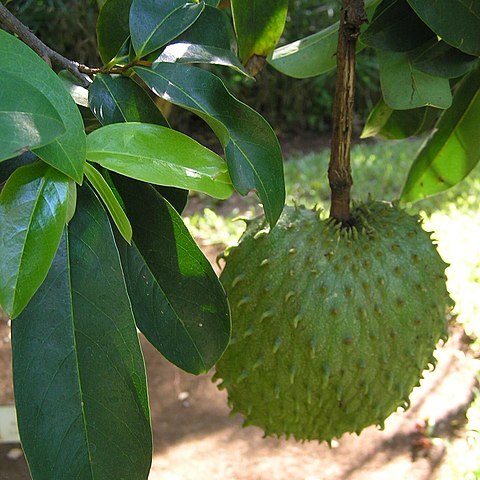Trees, shrubs or subshrubs, with simple or stellate hairs or glabrous. Flowers usually hermaphrodite, solitary, fasciculate or in few-flowered cymes, terminal, leaf-opposed or extra-axillary, pedicellate; buds globose, ovoid or elongate, 3-angled; bracteoles 0–2, persistent. Sepals 3, valvate, free, smaller than the petals. Petals usually 6 in 1–2 whorls, both valvate or the inner one imbricate, subequal or the inner ones reduced or absent, free or united at the base, thick and coriaceous, mostly suberect or connivent. Stamens numerous, linear or linear-clavate; filaments short; anther-cells sometimes unequal, extrorse; connective-prolongation obliquely capitate, dilated or ± apiculate. Carpels numerous, ± united, cylindrical, with 1 erect basal ovule; styles clavate; stigmas muricate. Fruit pedicellate, syncarpous, fleshy, indehiscent, ovoid-globose or cylindrical. Seeds numerous, irregularly arranged; aril terminal, compressed, annular or grooved and ridged so as to appear fibrillated.
Small or medium trees, unarmed, with simple hairs. Flowers bisexual, solitary or several in leaf-opposed, terminal or internodal cymes. Submedial and basal bracts present. Sepals valvate in bud, free or shortly connate. Petals free or rarely (not in Australia) connate, 6 in two series or inner series absent or rudimentary; outer petals valvate; inner petals when present valvate or imbricate in bud. Stamens mostly linear; filament short; connective truncate, flat or convex at apex. Pollen grains in tetrads. Carpels numerous, free or connate at anthesis; ovule 1, basal; stigma oblong or conical, sometimes nearly as long as ovary. Fruit a syncarpium, fleshy, indehiscent, many-seeded, mostly ovoid to globose. Seeds mostly obloid, sometimes bilaterally flattened, mostly brown, smooth or slightly undulate. See also Du Puy (1993: 63).
Trees or shrubs, with an indument of simple or stellate hairs. Inflorescences terminal, leaf-opposed, extra-axillary, or sometimes cauliflorous, never axillary, 1-flowered or in few-flowered clusters. Pedicel usually short. Sepals 3, small, valvate. Petals 6, in 2 whorls or inner whorl rudimentary or absent, free or connate at base; outer petals valvate, fleshy but leathery when dry, connivent or somewhat spreading, inside basally concave, margin thick; inner petals imbricate or valvate. Stamens many; filament short; connectives apically convex or apiculate. Carpels many, often connate; ovule 1 per carpel, basal; styles clavate; stigmas muriculate. Fruit syncarpous, surface covered with knobs, bulges, spines, or less often smooth. Seeds many per syncarp, embedded in edible pulp.
Shrubs or trees with simple or stellate hairs. Flowers solitary or in few-flowered inflorescences, terminal or opposite the leaves, or extra-axillary from the internodes. Sepals 3, small, valvate. Petals 6, free or connate at the base, biseriate, or the inner rudimentary or absent, the outer valvate, the inner imbricate or valvate. Stamens numerous, the anther cells not locellate, the connective generally terminat-ing in a swollen head or hoodlike process above the pollen sacs. Carpels numerous or rarely few; ovule 1, basal, erect. Fruit fleshy, formed by the concrescence of the carpels and the torus, usually areolate on the surface, the areoles, indicating the united carpels, being often gibbous or acuminate.
Evergreen or sometimes deciduous shrubs or trees, with simple or stellate hairs. Lvs ± coriaceous. Fls solitary or few together, terminal, or lateral and lf-opposed, sometimes cauliflorous. Sepals 3, valvate, small, connate at base. Petals 6, in 2 whorls, sometimes inner whorl reduced to scales or 0; outer petals fleshy, valvate, greenish or yellowish, ± concave. Stamens numerous; filaments fleshy, connective produced above and concealing anthers, forming a truncate disc apically. Carpels numerous, 1-seeded, soon becoming united; ovule basal. Fr. a fleshy syncarp, often large, sometimes the fleshy carpels only loosely cohering.
Petals 6, free or connate at the base, in two equal or ± unequal whorls, or the inner whorl sometimes absent, both valvate or the inner whorl imbricate, thick, coriaceous, connivent or suberect, concave at the base or throughout.
Stamens ?, linear or linear-clavate, with thecae extrorse and often unequal at the base, and connective-prolongation obliquely capitate or apiculate, sometimes ± papillose; filaments short.
Flowers usually bisexual, solitary or in few-flowered cymes or fascicles, terminal or extra-axillary or sometimes on the old wood, pedicellate.
Carpels numerous, free at first or united from the beginning, ± cylindric, with a single basal ovule; style clavate; stigma muricate.
Trees, shrubs or shrublets, not climbing, glabrous or with simple or stellate hairs.
Fruit a fleshy syncarp, ovoid-globose to cylindric, many-seeded.
Seeds irregularly arranged in the syncarp; aril carunculoid.
Sepals 3, valvate, much shorter than the petals, free.
Buds globose to conic or triquetrous.
Bracteoles 0–2, persistent.

